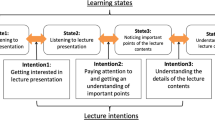Abstract
Information technology, including digital devices, robots, and the internet, is of great interest in the field of education. Many previous studies have focused on improving lecturer–student communication during lectures. In this paper, we describe a new robot-teleoperation system for transferring students’ opinions or questions to the lecturer. Through this system, users can collaboratively choose a message to be uttered by a robot. We report the results of a subjective experiment performed in a controlled lecture-style environment. The results show that participation, as estimated from behavioral and subjective measures, increased in lectures using the proposed system compared with those that did not use the proposed system or employed a reduced version of the proposed system in which the robot was controlled individually (i.e., non-collaboratively).



Similar content being viewed by others
References
King A (1994) Guiding knowledge construction in the classroom: effects of teaching children how to question and how to explain. Am Educ Res J 31(2):338–368
Gray P (1993) Engaging students’ intellects: the immersion approach to critical thinking in psychology instruction. Teach Psychol 20(2):68–74
Asch SE (1951) Effects of group pressure upon the modification and distortion of judgments. In: Guetzkow H (ed) Groups, leadership, and men. Carnegie: Pittsburgh, pp 222–236
Doyon P (2000) Shyness in the Japanese EFL class: why it is a problem, what it is, what causes it, and what to do about it. Lang Teach 24(1):11–16
Liu N-F, Littlewood W (1997) Why do many students appear reluctant to participate in classroom learning discourse? System 25(3):371–384
Turner JM, Hiraga MK (1996) Elaborating elaboration in academic tutorials: changing cultural assumptions. In: Change and language: papers from the annual meeting of the British Association for applied linguistics held at the University of Leeds, September 1994, vol 10. Multilingual Matters, p 131
Freeman M, Blayney P, Ginns P (2006) Anonymity and in class learning: the case for electronic response systems. Aust J Educ Technol 22(4):568–580
Mayer RE, Stull A, DeLeeuw K, Almeroth K, Bimber B, Chun D, Bulger M, Campbell J, Knight A, Zhang H (2009) Clickers in college classrooms: fostering learning with questioning methods in large lecture classes. Contemp Educ Psychol 34(1):51–57
Shapiro A, Sims-Knight J, O’Rielly GV, Capaldo P, Pedlow T, Gordon L, Monteiro K (2017) Clickers can promote fact retention but impede conceptual understanding: the effect of the interaction between clicker use and pedagogy on learning. Comput Educ 111:44–59
Christopherson KM (2007) The positive and negative implications of anonymity in internet social interactions: “on the internet, nobody knows you’re a dog”. Comput Hum Behav 23(6):3038–3056
Beatty ID, Gerace WJ, Leonard WJ, Dufresne RJ (2006) Designing effective questions for classroom response system teaching. Am J Phys 74(1):31–39
Wang AY, Newlin MH, Tucker TL (2001) A discourse analysis of online classroom chats: predictors of cyber-student performance. Teach Psychol 28(3):222–226
Scornavacca E, Huff S, Marshall S (2009) Mobile phones in the classroom: if you can’t beat them, join them. Commun ACM 52(4):142–146
Joinson AN (2001) Self-disclosure in computer-mediated communication: the role of self-awareness and visual anonymity. Eur J Soc Psychol 31(2):177–192
Kuno Y, Sadazuka K, Kawashima Mi, Yamazaki K, Yamazaki A, Kuzuoka H (2007) Museum guide robot based on sociological interaction analysis. In: Proceedings of the SIGCHI conference on human factors in computing systems. ACM, pp 1191–1194
Skantze G, Hjalmarsson A, Oertel C (2014) Turn-taking, feedback and joint attention in situated human–robot interaction. Speech Commun 65:50–66
Sproull L, Kiesler S (1986) Reducing social context cues: electronic mail in organizational communication. Manag Sci 32(11):1492–1512
Palinko O, Shimaya J, Jinnai N, Ogawa K, Yoshikawa Y, Ishiguro H (2018) Improving teacher–student communication during lectures using a robot and an online messaging/voting system. In: 2018 27th IEEE international symposium on robot and human interactive communication (RO-MAN). IEEE, pp 1–7
Ishiguro H (2007) Android science. In: Thmn S, Brooks R, Durrant-Whyte H (eds) Robotics research. Springer, Berlin, pp 118–127
Fujimoto M, Ikuo D (2007) Integration of factors on communication skill to hierarchical structure. Person Study 15(3):347–361 (in Japanese)
Wallach MA, Kogan N, Bem DJ (1964) Diffusion of responsibility and level of risk taking in groups. J Abnorm Soc Psychol 68(3):263
Gardner M, Steinberg L (2005) Peer influence on risk taking, risk preference, and risky decision making in adolescence and adulthood: an experimental study. Dev Psychol 41(4):625
Acknowledgements
This work was supported by Japan Society for the Promotion of Science (JSPS) KAKENHI Grant Number 18H04114 and JST-Mirai Program Grant Number JPMJMI18C6, Japan.
Author information
Authors and Affiliations
Corresponding author
Ethics declarations
Conflict of interest
Yuichiro Yoshikawa and Hiroshi Ishiguro serve as consultants of Vstone Co. Ltd.
Ethical Statement
In this study, ethical approval was received from Graduate School of Engineering Science, Osaka University.
Additional information
Publisher's Note
Springer Nature remains neutral with regard to jurisdictional claims in published maps and institutional affiliations.
Rights and permissions
About this article
Cite this article
Shimaya, J., Yoshikawa, Y., Palinko, O. et al. Active Participation in Lectures via a Collaboratively Controlled Robot. Int J of Soc Robotics 13, 587–598 (2021). https://doi.org/10.1007/s12369-020-00651-y
Accepted:
Published:
Issue Date:
DOI: https://doi.org/10.1007/s12369-020-00651-y




